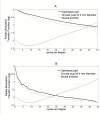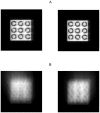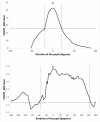Improving vision by pupil masking
- PMID: 27446688
- PMCID: PMC4948612
- DOI: 10.1364/BOE.7.002538
Improving vision by pupil masking
Abstract
We propose an alternative solution to improve visual quality by spatially modulating the amplitude of light passing into the eye (related to the eye's transmittance), in contrast to traditional correction of the wavefront phase (related to the local refractive power). Numerical simulations show that masking the aberrated areas at the pupil plane should enhance visual function, especially in highly aberrated eyes. This correction could be implemented in practice using customized contact or intraocular lenses.
Keywords: (330.0330) Vision, color, and visual optics; (330.1070) Vision - acuity; (330.4460) Ophthalmic optics and devices.
Figures





Similar articles
-
Enhanced visual acuity and image perception following correction of highly aberrated eyes using an adaptive optics visual simulator.J Refract Surg. 2010 Jan;26(1):52-6. doi: 10.3928/1081597X-20101215-08. J Refract Surg. 2010. PMID: 20199013
-
Phakic intraocular lenses for the treatment of refractive errors: an evidence-based analysis.Ont Health Technol Assess Ser. 2009;9(14):1-120. Epub 2009 Oct 1. Ont Health Technol Assess Ser. 2009. PMID: 23074518 Free PMC article.
-
VioBio lab adaptive optics: technology and applications by women vision scientists.Ophthalmic Physiol Opt. 2020 Mar;40(2):75-87. doi: 10.1111/opo.12677. Epub 2020 Mar 8. Ophthalmic Physiol Opt. 2020. PMID: 32147855 Review.
-
Effect of rotation and translation on the expected benefit of an ideal method to correct the eye's higher-order aberrations.J Opt Soc Am A Opt Image Sci Vis. 2001 May;18(5):1003-15. doi: 10.1364/josaa.18.001003. J Opt Soc Am A Opt Image Sci Vis. 2001. PMID: 11336203
-
Advanced Optical Wavefront Technologies to Improve Patient Quality of Vision and Meet Clinical Requests.Polymers (Basel). 2022 Dec 5;14(23):5321. doi: 10.3390/polym14235321. Polymers (Basel). 2022. PMID: 36501713 Free PMC article. Review.
Cited by
-
Comment on: Keratopigmentation; a comprehensive review.Eye (Lond). 2021 Jan;35(1):354. doi: 10.1038/s41433-020-0828-x. Epub 2020 Feb 24. Eye (Lond). 2021. PMID: 32094476 Free PMC article. No abstract available.
-
Improvement in Near Vision Following Silodosin Treatment in Patients With Lower Urinary Tract Symptoms.Int Neurourol J. 2021 Jun;25(2):164-171. doi: 10.5213/inj.2040274.137. Epub 2021 Jan 19. Int Neurourol J. 2021. PMID: 33504125 Free PMC article.
-
The optics of the human eye at 8.6 µm resolution.Sci Rep. 2021 Dec 2;11(1):23334. doi: 10.1038/s41598-021-02653-w. Sci Rep. 2021. PMID: 34857820 Free PMC article.
-
Catastrophe optics theory unveils the localised wave aberration features that generate ghost images.Ophthalmic Physiol Opt. 2022 Sep;42(5):1074-1091. doi: 10.1111/opo.13008. Epub 2022 May 27. Ophthalmic Physiol Opt. 2022. PMID: 35620968 Free PMC article.
-
Femtosecond laser-assisted keratopigmentation outcomes for pure cosmetic purposes.Am J Ophthalmol Case Rep. 2025 Mar 7;38:102297. doi: 10.1016/j.ajoc.2025.102297. eCollection 2025 Jun. Am J Ophthalmol Case Rep. 2025. PMID: 40151591 Free PMC article.
References
-
- Helmholtz H., Popular Lectures on Scientific Subjects (London: Longman, Green, 1873).
-
- Holladay J. T., Piers P. A., Koranyi G., van der Mooren M., Norrby N. E., “A new intraocular lens design to reduce spherical aberration of pseudophakic eyes,” J. Refract. Surg. 18(6), 683–691 (2002). - PubMed
-
- Fried D., “Probability of getting a lucky short-exposure image through turbulence,” J. Opt. Soc. Am. 68(12), 1651–1657 (1978).10.1364/JOSA.68.001651 - DOI
LinkOut - more resources
Full Text Sources
Other Literature Sources
